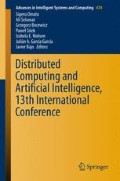Abstract
Most of the underwater target recognition method are built on the spectral analysis. The recognition accuracy isn’t high in the short attack time which leads the torpedo attack on the false target. A method which take the tracking, trajectory and optimum seeking data join have been put forward, which can use the targets’ various information for tracking, trajectory control, optimum seeking, so multiple information can be used for other processes. The method can take full advantage of all key data during the attacking progress which can improve the recognition and attack accuracy. The final attack simulation results verified the high accuracy of the method.
Access this chapter
Tax calculation will be finalised at checkout
Purchases are for personal use only
Preview
Unable to display preview. Download preview PDF.
References
Li, X., et al.: Classification of underwater target echoes based on auditory perception characteristics. J. Marine Sci. Appl 13, 218–224 (2014)
Kean, C., et al.: Subjective evaluation experiments of timbre attribute based acoustic target identification. Chinese Sci. Bull. 55, 651–659 (2010)
Na, W., Kean, C.: Application of subband spectral centroid features to recognizing underwater targets. Acta Armamentarii 30, 144–149 (2009)
Song, Z., et al.: The method of underwater target recognition based on LOFAR spectrum. Journal of Naval Aeronautical Engineering Institute 26, 283–286 (2011)
Deng, K., Xiang, X., Gu, Z.: Multi-highlight model of scaling acoustic decoy. Technical Acoustics 30, 201–205 (2011)
Liu, C., Fu, Z., Wang, M.: Underwater target identification based on the methods of bearing and cross-spectrum. Acta Armamentarii 27, 933–935 (2006)
Ning, X., Zhao, X.M., Cheng, J.T.: A way to Identify Targets Based on Dimension Spectrum and SVM. Control & Automation 24, 196–197 (2008)
Liang, K.-H., Wang, K.-M.: Using simulation and evolutionary algorithms to evaluate the design of mix strategies of decoy and jammers in anti-torpedo tactics. In: Proceedings of the 2006 Winter Simulation Conference, Monterey, CA, pp. 1299–1306. IEEE (2006)
Tu, C.-K., et al.: Applying genetic algorithms on fuzzy logic system for underwater acoustic signal recognition. In: Proceedings of the 2000 International Symposium on Underwater Technology, pp. 405–410 (2000)
Tucker, S., Brown, G.J.: Classification of transient sonar sounds using perceptually motivated features. IEEE Journal of Ocean Engineering 30, 588–600 (2005)
Young, V.W., Hines, P.C.: Perception-based automatic classification of impulsive-source active sonar echoes. Journal of the Acoustical Society of America 122, 1502–1517 (2007)
Yu, L., et al.: Underwater acoustic multi-target recognition algorithm based on hierarchical information fusion structure. In: 17th International Conference on Information Fusion, Salamanca, Spain (2014)
Chen, C., et al.: Anti-torpedo technology. National Defense Industry Press, Beijing (2006)
Author information
Authors and Affiliations
Corresponding author
Editor information
Editors and Affiliations
Rights and permissions
Copyright information
© 2016 Springer International Publishing Switzerland
About this paper
Cite this paper
Yu, L., Cheng, Ym., Chen, Kz., Liu, Jx., Liu, Zg. (2016). An Underwater Target Recognition Method Based on Tracking, Trajectory, and Optimum Seeking Data Joint. In: Omatu, S., et al. Distributed Computing and Artificial Intelligence, 13th International Conference. Advances in Intelligent Systems and Computing, vol 474. Springer, Cham. https://doi.org/10.1007/978-3-319-40162-1_20
Download citation
DOI: https://doi.org/10.1007/978-3-319-40162-1_20
Published:
Publisher Name: Springer, Cham
Print ISBN: 978-3-319-40161-4
Online ISBN: 978-3-319-40162-1
eBook Packages: EngineeringEngineering (R0)

